Entries in Kites Around the World (19)
Effects of the Kite Flying Ban Imposed on Pakistan's Basant Festival in 2005
There has been much discussion about the effects of the kite flying ban imposed in 2005 in Pakistan to curtail the sale and flying of kites for the spring Basant festival.
The ban was supposedly implemented to reduce the number of fatalities and the damage caused by thousands of kites flown during the Basant festival. There can be no doubt that the glass and chemical coated string did cause a good deal of damage and injury to some citizens and birds. When taut, the coated kite string can cut flesh and has been documented to be the cause of serious injury and even death each year.
In addition, some segments of the population saw the kites and kite flying aspects of Basant as too secular and against more traditional religious beliefs and customs.
So, in 2005 the Pakistan government passed a law banning the sale of the kites and kite line during the festival. This severly hampered the livelihood of kite makers and vendors. In addition, the ban also affected the sights and flavour of the Basant festival. Formerly the skies were filled with colourful battling kites by the hundreds and thousands, Today, only a few daring kiters send their kites soaring to the skies.
It is feared by some that the rich tradition of Pakistani kite making and flying will be lost over the coming years.
In March of 2010 the English language branch of the AlJazeera Network examined the current kite flying situation during Basant in Pakistan.
The history of kites and kite flying in Pakistan has a long and rich history. One can only hope that the skills of kite making and kite flying will not be lost over the coming years.
Note:
For additional background on the kites of Pakistan and their role in the festival of Basant, see my earlier article entitled: Kites in Pakistan: the kites of Basant in Lahore, Pakistan.
Kite Flying - A World Wide Activity
A recent email from a close kite flyer friend of mine made me realize how small the world has become with modern travel and communication systems.
It is possible to use our computers to learn about events all over the world in real time. Television's video magic makes us feel as though we are at events as they happen. Streaming video and sites like YouTube allow us to experience what is going on no matter where it is happening. The ease of travel can take you from your home to the other side of the world in less than a day.
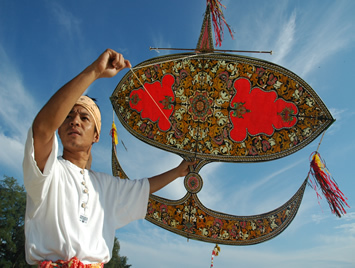 My friend is travelling to the famous kite festival in Pasir Gudang (Johor), Malaysia in a few days. Pasir Gudang is located on the mainland across from the island of Singapore.
My friend is travelling to the famous kite festival in Pasir Gudang (Johor), Malaysia in a few days. Pasir Gudang is located on the mainland across from the island of Singapore.
Held at the end of the second week in February each year, the Pasir Gudang kite festival is known around the world as an intersection point for kiters from around the world. At this festival, kite fliers from Europe, India, China, Australia, New Zealand, the United States and Canada will mingle with kiters flying traditional Malaysian "wau" kites. It is indeed a blend of all the best the world has to offer in a variety of kites defined by visitors from different global locales.
The Pasir Gudang Kite Museum is located here, on top of Kite Hill. It is the first kite museum in Malaysia and has a unique working windmill that generates enough electricity to supply the daily needs of the museum. What could be more appropriate for a kite museum than to use the wind to provide green energy.
Nor is this the only kite festival to take place in Malaysia. Malacca, the third smallest Malaysian state, located in the southern region of the Malay Peninsula, on the Straits of Malacca also recently hosted a major international kite festival. The Star Online in Malacca reported that "about 200 kite enthusiasts from all over the country gathered at the Dataran Pahlawan field in Bandar Hilir, Malacca, to take part in the Third Malaysia-China 2009 Kite Flying Festival recently". The festival was also attended by European flyers from as far away as Finland.
This is not the only location where kiting is flourishing in the large global community.
Recent news reports from around the world cited major kiting activity in every corner of the world.
India and Pakistan: recent reports of the major kite flying activity that is associated with the celebration of Utterayan and Makhar Sankranti (India) and Basant (Pakistan) have been streaming steadily from news agencies in the Asian sub-continent.
- India:
"May it be Republic Day or Independence Day or Makar Sakranti or Janamashtami, more and more people in north India are taking to kite flying on such days. In a way, kite flying is becoming a festival by itself. The Indian festival of Makar Sakranti is devoted to kite flying and fighting in some states. This year the festival was celebrated on January 14, with millions of people flying kites all over northern India.
The states of Bihar, Jharkhand, Gujarat, and some part of West Bengal, Rajasthan, Andhra Pradesh and the cities of Ahemdabad, Baroda, Jaipur, Dhanbad and Hyderabad are particularly notable for their kite fighting festivals."
From: MyNews.in
Also: Kites colour the skies and unite the world
- Pakistan: A kite fighting ban imposed by the Pakistan Supreme Court has been effect for several years now due to the number of injuries and deaths that have occurred due to kite flying. In Pakistan, as in India, kite fighting is the ultimate kite flying challenge. Kiters duel it out in the skies cutting one another's kited from the skies using glass and chemically coated kite line to assist in severing the kite of an opponent and thus win the battle. The details surrounding this ban and some of the background can be found here on the Best-Breezes site by using the Search function to see previous articles. However, this year there were calls to lift the ban and legitimize the kite flying that continues in spite of the ruling against the use of sharp kite line. The Daily Times of Lahore reported:
"According to a poll conducted by the channel, approximately 75 percent of the city’s residents favoured kite flying in celebration of the spring festival. Residents say the ban on kite flying not only deprived the people of celebrating and enjoying a festive occasion but also adversely affected the developing industry of manufacturing kite-related products, the channel reported. Overall, the Punjab government’s initiative to consider lifting the ban was welcomed by the public, it added."
Australian and New Zealand kite festivals are in full swing now as the Southern Hemisphere is enjoying summer. These two locales have produced some of the most innovative modern kites to grace the skies at kite festivals in the past decade. Recently, the Tip-Top Kite Day was held in ChristChurch, NZ and featured international kiters in attendance from as far away as The Netherlands. So it is clear that kiting is flourishing in this region as well.
Europe has a number of outstanding festivals: Dieppe France, Bristol in Great Britain, Schveningen in The Netherlands and Fano in Denmark are well known gathering spots for international kite fliers.
North America has a large number of festivals of note: the Niagara International Kite Festival in Niagara Falls, NY; Wildwood in New Jersey; the Smithsonian Kite Festival in Washington, D.C.; Sunfest in Ocean City, Maryland; the Washington State Kite Festival and Dieppe, New Brunswick are among the many events in this continent that attract noted fliers from around the world.
Each of these events has a major impact on the dissemination of current kite knowledge and innovation. In addition, the kites in the sky bring delight to local spectators and tourists who increasingly add these events to their itineraries.
The list could go on and on. However, just using these examples it is safe to conclude that kite flying as a world wide activity is alive and well. The ability to use modern communication keeps us in touch with these events as they happen. Modern transportation allows us to place ourselves on these noted kite fields with the best kiters in the world. It is a small world and somewhere a kite is flying in the sky at all times.
Chinese Centipede Kites - The Whole is Greater Than the Sum of Its Parts!
China is viewed as one of two possible locations where kites originated thousands of years ago.
The artistry and structure of Chinese kites is unique in the world. Using materials native to China, the early kite crafters developed unique skills in shaving and shaping bamboo into diverse shapes and framing structures. The development of unique and strong papers for sails combined with specialized colored inks allowed images to be painted on the sails by Chinese artists and artisans. This combination of creatively shaped and strong kites created some of the most amazing tethered flying devices in the world.
 One type of Chinese kite links many similar segments into a train-like configuration that, when completed and raised in flight, creates a striking kite composition where the whole becomes greater than the sum of its individual parts.
One type of Chinese kite links many similar segments into a train-like configuration that, when completed and raised in flight, creates a striking kite composition where the whole becomes greater than the sum of its individual parts.
This genre of kite is known as a 'centipede' kite. Similar in some ways to a kite train, the centipede kite provides one striking difference when viewed in flight: -the total visual effect of its many parts combine to create a single, stunning image in the sky.
Two dramatic examples of this type of kite are the famous Chinese dragon kites and a recent iteration, the Great Wall of China kite.
________________________________________________________________________________
Chinese Dragon Kite:
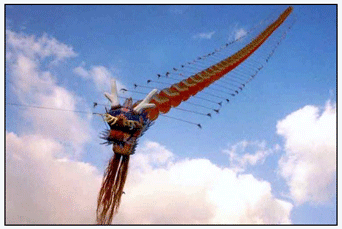
The Chinese dragon kite has a long history that is tied to the symbolic importance of the dragon in the cultural lore of the nation. The dragon has long been viewed as a potent symbol of auspicious power in Chinese art and folk tales. The dragon is deeply entwined in Chinese culture and its meanings are deep and varied depending on the geographical region and the era of Chinese history.
With its embodiment in literature and art, it was to be expected that symbolic representations of the dragon would take flight in Chinese skies. There seems to be no precise information to suggest a date that has been historically established to confirm when the first Chinese dragon kites took to the skies, or in which exact area of the country they were first created and flown.
However, the Chinese dragon kite is an arresting and striking visual display when it is launched at any modern kite festival. The color, intricate construction and repetition of the segments of its body undulating in the breeze as it lifts skyward from its imposing head to its far off tail are simply captivating.
This kite is known as a "centipede" type of kite in that the repeated segments that follow behind the dragon's head are all identical in size and shape and are linked to make the dragon's body form, much as a centipede has a distinct head followed by many similar segments to its body. As with the centipede, the dragon kite as a visual whole is much greater than the sum of its individual parts.
___________________________________________________________________________________________
The Great Wall of China Kite:
A very recent kite that made the global news, is the kite that represents the Great Wall of China. Although not in the shape of the traditional Chinese dragon kite, this kite has all the characteristics of a 'centipede kite' form: multiple repeated segments that are attached to a lead section. When combined, all these elements provide a total, integrated kite image in the sky.
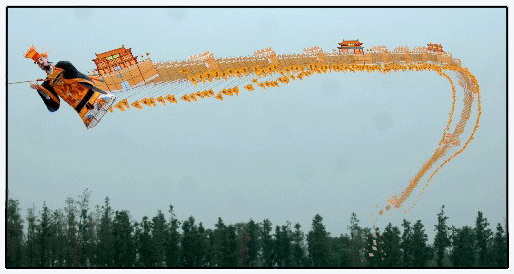
This kite was constructed during a three year period from 2006 to 2008. It was flown for the first time on June 22, 2008. The kite was crafted by Zhang Tianwei, a master in kite design. Composed of two parts, the kite had a portrait of Qin Shihuang leading the head position, followed by a more-than-100-meter micro great wall. The giant kite is 130 metres in length and 12 kilograms in weight.. Due to its heavy weight, the kite needs at least 10 people to fly it in winds of 12 to 20 kph.
Qin Shihuang was the first emperor of China who founded Qin Dynasty after conquering six other countries in the Warring States Period. He was also the man who conceived of and started the building of the Great Wall to fend off foreign invasions. Kite creator Tianwei felt that an image of the Great Wall could be recreated in a kite that would reach off into the distance and undulate in the breeze just as the physical Wall itself rambles over varying terrain in China.
Single Kite or Train of Kites?

The Chinese 'centipede' type of kite is considered to be one single kite, an amalgam of segments creating a single visual entity. The two kites described and shown above are perfect examples of this.
Typically a 'train' of kites embodies a linked line of kites that are the exactly the same which do not suggest one single visual concept theme.
An example of a kite train is shown to the right. The kite train genre features all kites, including the lead kite, made of the same design structure.
Although the visual effect in the sky is usually quite arresting, it is very different from the effect created by a 'centipede' type kite where the entire array of similar kite elements evokes a collective idea that is greater than that created by the string of kites in a typical kite train.
The train of kites shown flying above was designed and built by the author.
References and Citations:
1. Background information on dragons and their role in the culture of China is from Wikipedia, The Free Encyclopedia.
2. Image of Chinese dragon kite, of centipede variety, is from The Dragon Cave web site.
Videos of Chinese Centipede (Dragon) Kites:
Since writing this article, I have had several requests for more information on kite trains and, in particular, the Chinese centipede/dragon type kites.
Two video resources that provide insight into these magnificent kites are provided here.
Making a kite of this type is very time consuming. They are among the most beautiful kites in the world. Their long history and link to the culture of China ensures that these kites attract much attention wherever they are flown.
Kites Soar Above Political Turmoil
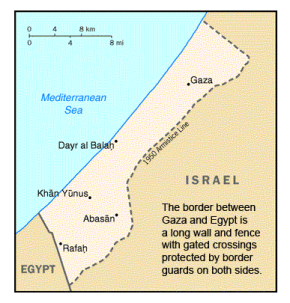 In one of the most dramatic recent examples of kites bridging geo-political divisions, comes a story from the border between Egyptand the Gaza strip in Palestinian territory.
In one of the most dramatic recent examples of kites bridging geo-political divisions, comes a story from the border between Egyptand the Gaza strip in Palestinian territory.
A news report by journalist Mohammed Omer, on the web site of the Inter Press Service International Association located in Rome, Italy, shows the power of kites to focus people on matters other than war and widely differing politics.
The story, entitled "Kites Rise Above Divisions" outlines how two young boys, one in Egypt and the other in Gaza, are able to reach above the dividing wall of the border and challenge one another in a test of skill and maneuverability. Even though the boys cannot see one another, as they look skyward they are able to recognize one another's kites by their construction and the approximate place on the ground from which they are flown.
Differing economic conditions point are still visible in the sky, Mohammed Omer notes, as the sails on kites from Gaza are made of newspaper and plastic bags while the kites of the Egyptian boys are made of traditional materials like colorful tissue paper and glue.
In the sky, the challenge is on - boys playing with one another in a test of wills and wits with a simple desire to enjoy the opportunities of a playful diversion and better a friendly adversary in a non-life threatening manner.
Mohammed Omer's story is not an isolated incident of kites soaring above the border with children engaging in skillful competition in the sky. The occurrence of kite flying contests between children from Gaza and Egypt happens on a regular basis.
In a dramatic blog posting on May 17, 2007 by Laila El-Haddad, a journalist mother who divides her time between Gaza and the United States, the contrasts between war and the peaceful activity of children flying kites on both sides of the Egypt-Gaza border are clearly outlined. Laila El-Haddad wrote about one such day of contrasts thus:
"After a terrifying 24 hours, we awoke this morning to sporadic gunfire, and ghostly streets."
"Though the gunfire had subsided, the gunmen were still patrolling the streets, each this time casually manning their own turf, masked and fully armed."
"We decided to avoid the town centre, and headed instead to film near the border area along Rafah’s edge. Young children blissfully flew handmade kites above the iron wall separating them from the Egyptian Rafah. Their "atbaq" flirted in the infinite sky above with kites flying their way from the Egyptian side. "We play a game with the Egyptian kids" they explained of their unseen counterparts. "We meet here, through our kites, and see who can catch the other's kites quicker by entangling. So far we're winning-we've got 14 Egyptian kites" he announced proudly."
"The children are small enough that they can wiggle their way through the cracks of the large iron gates along the wall-where once Merkava tanks made their unwelcome entrance to battered camps here. And so they can call out to their Egyptian friends, and learn their names and new kite flying techniques."
So it is with kites - their ability to reach into the sky, to ride on the wind, to challenge each flyer to master the currents and the capabilities of their own tethered aircraft will always rise above the seemingly intractible divisions of geopolitical differences.
It makes one wonder if we should have more adults flying kites rather than grinding on with the same old politics.
At least while flying a kite they would look up, see the sky and feel the pull of the wind. The sky knows no borders and the wind does not stop at border crossings. The friendly challenges of skill allows one to learn of your counterpart in terms other than politics and opens a window on the possibility of seeing your opponent as an individual, rather than a stereotypical member of group politics. Perhaps there are serious lessons to be learned through kites!
__________________
Notes:
- Kites flown by children in Egypt and Gaza tend to be of the generic, maneuverable single line 'fighter kite' type. Usually the sail is made of tissue paper with bamboo or similar shapable wooden spars for framing. Sometimes, newspaper or plastic bags are substituted for sail material if the more expensive tissue paper is not available.
- Kites made of more modern ripstop sailcloth material can sometimes be found in the sea coast tourist areas of Egypt.
- The Egyptian sea coast resorts are popular spots for tourists who engage in the expensive sport of kite boarding using modern kites by Naish and designs by Peter Lynn.
Afghan Kites Get a Lift from European Troops - Patang! Patang!
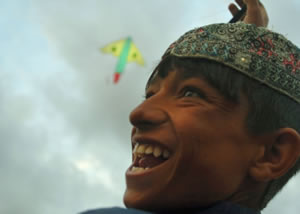 Kites returned to most areas of Afghanistan after the Taliban government left office in 2002 when American troops entered the country. The Taliban had banned kite flying as a frivolous and 'non-Islamic' activity. Kites again took to the skies in the nation's capital, Kabul, right after the exit of the Taliban regime.
Kites returned to most areas of Afghanistan after the Taliban government left office in 2002 when American troops entered the country. The Taliban had banned kite flying as a frivolous and 'non-Islamic' activity. Kites again took to the skies in the nation's capital, Kabul, right after the exit of the Taliban regime.
Some areas of Afghanistan remained under local Taliban influence long after a new government was installed in Kabul. In these areas, kite making and kite flying were still not permitted.
Recently, the Polish Battle Group, part of a coalition force that is patrolling parts of Afghanistan in support of the new government, entered Ghazni province’s Andar district. Here, kite flying was still banned due to the local influence of Taliban sympathizers.
Since there is a strong tradition of kite making and kite flying in the Afghan culture (see previous stories in this Blog), the Polish troops came equipped with kites to aid them in making friends with the local residents.
Speaking to Black Anthem Military News, Polish Pfc Chris Demko reported:
“It seems like time stopped here 2,000 years ago. We see these kids running around with nothing, not even shoes, and we want to change that.”
Everywhere they went, children crowded around the vehicles as the smiling soldiers pulled out boxes of shoes, clothes, school supplies and toys. But the biggest hit of all were the multi-colored kites that the soldiers unfolded for them.
With big grins and excited chattering, the children jumped up and down shouting, “Patang! Patang!” (the Pashto word for kite.)
Soon the sky had several of the yellow, green and red kites with International Security Assitance Forces logos flying, much to the delight of the children dancing around below.
“These kites are so much fun,” said Mahmad-Amid Hahn, a 12-year- old boy, as he made whooping sounds while his kite dipped and swerved in the air. “The Taliban would never give us these things.”
For the children who had never seen a kite before, some of the Polish soldiers stepped in to assist, unfolding the kites and showing them how to take off with a running start to get it airborne.
In addition to the kites, the Polish forces distributed food, clothing, medical supplies and school supplies in an effort to assist the local people.
The kites that quickly climbed into the skies, however, seemed to be a large symbol that things had changed in the region.
_________________
Photo credit: U.S. Army photo by Spc. Micah E. Clare




